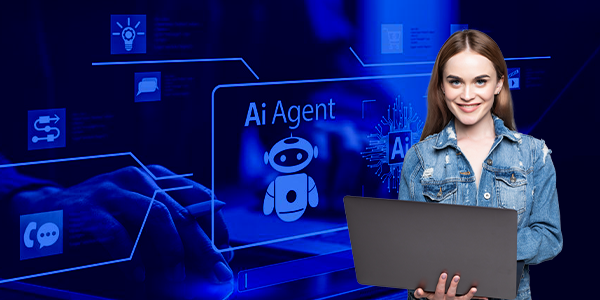As businesses increasingly acknowledge the revolutionary capabilities of artificial intelligence, deploying AI agents has become a pivotal approach for achieving a competitive edge and boosting operational effectiveness. Much like the progression of intelligent automation in fields such as finance and healthcare, AI agents now signify the forefront of applied artificial intelligence. They go beyond conventional analytics, enabling systems to sense, decide, and act with significant independence. For technology leaders navigating this intricate domain, grasping the fundamental architectural frameworks supporting AI agent creation is now essential.
There are two popular approaches in this space:
- Agent-to-Agent (A2A), and
- Multi-Component Pipeline (MCP) architectures.
Understanding AI Agents: Beyond Traditional Analytics
AI agents represent a significant evolution from traditional machine learning approaches that have dominated data science practices for the past decade. While conventional models are designed to make predictions or classifications based on patterns identified in data, AI agents are built to interact with their environment, make decisions, and take actions to achieve specific objectives. This shift from passive prediction to active decision-making is fundamentally changing how AI systems are conceptualized, developed, and deployed across industries.
At its core, an AI agent embodies the concept of agency—the capacity to act independently and make choices based on its perception of the environment. For an AI system to exhibit agency, it needs to demonstrate autonomy, reactivity, proactivity, and social interaction. These qualities are vital, allowing AI agents to navigate and perform in complex, ever-changing environments where relying solely on fixed instructions isn’t feasible.
AI agents find applications across just about every industry. For instance, in the financial industry, these agents are being adopted for automated trading strategies, detecting fraudulent activities, and providing personalized investment advice. Healthcare providers are leveraging autonomous systems for precise medical diagnoses, crafting individualized treatment regimens, and vigilant patient oversight. In the manufacturing sector, agents play a role in optimizing production workflows, predicting potential equipment breakdowns, and upholding rigorous quality standards. This range of implementations highlights the significant versatility and potential benefits AI agents offer throughout an organization’s operations.
Agent-to-Agent (A2A) Architecture: Collaborative Intelligence
Agent-to-Agent (A2A) architecture describes a system where numerous specialized agents work collaboratively to complete complex tasks. This is achieved through structured communication and coordination. Much like human teams with varied expertise, the premise of A2A is that the combined intelligence of these specialized agents can achieve better outcomes than any single, standalone agent.
When using the A2A framework, every agent would be designed to have specific capabilities, keeping in mind the required domain knowledge and objectives for creating that agent. These agents interact through defined communication protocols, sharing information, delegating tasks, and collaborating on problem-solving. This distributed approach enables sophisticated reasoning and decision-making processes that more closely mimic human collaborative intelligence.
The core purpose of A2A architecture lies in its ability to decompose complex problems into manageable components that specialized agents can address. For instance, in a customer service application, one agent might handle natural language understanding, another might retrieve relevant information from knowledge bases, while a third might generate appropriate responses. These agents work in concert, each contributing its expertise to the overall solution.
Data flow in A2A systems typically follows a nonlinear, dynamic pattern. Information moves between agents based on task requirements and agent capabilities rather than through a predetermined sequence. This flexibility allows for adaptive problem-solving approaches that can adjust to changing circumstances or unexpected inputs. The architecture supports both hierarchical and peer-to-peer agent relationships, enabling diverse organizational structures based on your specific business requirements.
From an enterprise perspective, A2A offers significant advantages in modularity and maintainability. Each agent can be developed, tested, and updated independently, reducing the complexity of system maintenance and enabling iterative improvements without disrupting the entire architecture. This modular approach facilitates the incorporation of new capabilities through the addition of specialized agents, allowing your organization to expand system functionality incrementally.
Multi-Component Pipeline (MCP) Architecture: Streamlined Processing
Multi-Component Pipeline (MCP) architecture presents an alternative approach to agent development, structuring the system as a sequence of specialized components that process information in a predetermined order. This linear arrangement resembles an assembly line, where each component performs specific transformations on the input before passing the results to the next stage. The MCP paradigm emphasizes process efficiency, predictable data flow, and clear separation of concerns.
In an MCP framework, components are designed to handle distinct aspects of the overall task, such as data preprocessing, feature extraction, inference, decision-making, and action generation. These components operate in a coordinated sequence, with the output of one component serving as the input for the next. This structured approach enables straightforward reasoning about the system’s behavior and simplifies the implementation of monitoring and quality control mechanisms.
The core purpose of the MCP architecture centers on the reliable, consistent processing of inputs to generate appropriate outputs. MCP encourages transparency, debuggability, and performance optimization by breaking down complex processes into smaller, well-defined steps. Each of these smaller components can be fine-tuned for its specific function without requiring an understanding of the entire system, enabling specialized expertise to be applied where it delivers the greatest value.
In MCP systems, data moves in a clear, one-way direction from where it enters to where it exits. This makes it easier to manage, monitor, and govern all the data, making it especially valuable in industries that are highly regulated where process transparency and auditability are indispensable. The architecture naturally supports extensive logging and tracing capabilities, enabling detailed analysis of how information transforms at each stage of processing.
From a practical implementation standpoint, MCP offers advantages in scalability and performance optimization. Each component can be scaled independently, depending on its unique resource and processing needs. This targeted resource allocation enables efficient utilization of computing infrastructure and facilitates cost-effective system expansion as your usage grows. The predictable data flow also simplifies the identification and resolution of performance bottlenecks, as issues can be isolated to specific components within the pipeline.

Strategic Comparison: Making the Right Choice for Your Enterprise
When evaluating A2A and MCP architectures for your organization’s AI agent initiatives, several critical factors deserve consideration. Your choice should align with your specific business requirements, technical capabilities, and strategic objectives rather than following generic industry trends.
Architecturally, A2A offers greater flexibility and adaptability, enabling dynamic problem-solving approaches that can evolve with changing circumstances. This adaptability comes at the cost of increased complexity in agent coordination and communication protocols. Conversely, MCP provides clearer structure and predictability, facilitating easier implementation and maintenance but potentially limiting the system’s ability to handle novel or ambiguous situations that fall outside its predefined processing logic.
In terms of capabilities, A2A excels in scenarios requiring collaborative reasoning, creativity, and adaptation to novel situations. The interaction between specialized agents enables sophisticated problem-solving approaches that can address complex, multifaceted challenges. MCP demonstrates strengths in consistent execution of well-defined processes, reliable performance at scale, and transparent operation for monitoring and governance purposes.
Security considerations differ significantly between these architectures. A2A systems present more complex security challenges due to their distributed nature and inter-agent communication requirements. Securing message passing between agents, preventing unauthorized agent interactions, and maintaining system integrity require comprehensive security frameworks. MCP architectures typically offer more straightforward security implementations, with clear boundaries between components and well-defined data flows that simplify access control and monitoring.
From a development and maintenance perspective, A2A typically requires more sophisticated design patterns and coordination mechanisms. Agent interactions can be quite complex, making it essential to deploy careful planning and clear communication protocols. MCP offers more straightforward implementation approaches, with clear interfaces between components and sequential processing logic that aligns with traditional software engineering practices. Your organization’s existing technical capabilities and expertise should inform which approach better aligns with your development resources.
Performance characteristics also differ between these approaches. A2A systems may introduce latency through inter-agent communication overhead, but offer potential efficiency gains through parallel processing and specialized agent optimization. MCP architectures typically provide more predictable performance characteristics, with clearly defined processing stages that can be individually optimized and monitored. Your application’s specific performance requirements, particularly regarding latency sensitivity and throughput demands, should influence your architectural choice.
Integration Considerations for Enterprise Environments
Beyond the architectural considerations, the successful implementation of either approach within your enterprise environment requires careful attention to integration with existing systems and processes. Both A2A and MCP architectures must interface with your data infrastructure, operational systems, and business workflows to deliver tangible value.
For A2A implementations, focus on designing communication protocols that enable smooth interaction not only between agents but also with external systems. API management becomes particularly critical, as agents will likely need to access diverse data sources and services across your organization. Consider implementing orchestration layers that can manage agent interactions while providing clear integration points for existing enterprise systems.
With MCP implementations, emphasize clean component interfaces and well-defined data contracts between pipeline stages. This structured approach facilitates straightforward integration with existing processes and systems. Pay particular attention to input and output transformations at the pipeline boundaries to ensure compatibility with your current data formats and structures.
Regardless of the architecture you select, governance considerations remain paramount. Establish clear monitoring, logging, and auditing mechanisms to maintain visibility into your AI agents’ operations. Define appropriate control mechanisms and human oversight protocols, particularly for agents making consequential decisions that impact customers or business operations.
As you evaluate A2A and MCP approaches for your organization, remember that hybrid architectures are also viable. Some enterprises achieve optimal results by combining elements of both paradigms, leveraging the collaborative intelligence of A2A for complex reasoning tasks while employing MCP structures for consistent, high-throughput processing components. This pragmatic approach allows you to apply the most appropriate architecture to different aspects of your AI agent ecosystem based on specific requirements and constraints.
The journey toward implementing AI agents represents a significant evolution in your organization’s artificial intelligence capabilities. By understanding the strengths, limitations, and applications of A2A and MCP architectures, you position yourself to make informed decisions that align with your strategic objectives and operational realities. As with any transformative technology, the most successful implementations will be those that thoughtfully adapt these architectural paradigms to address your specific business challenges and opportunities.

